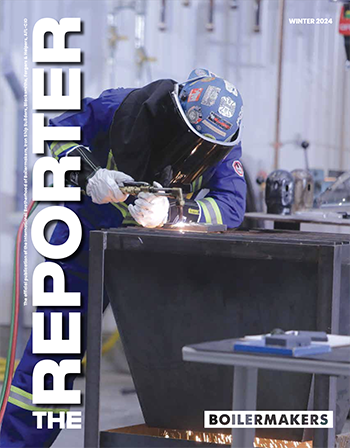Renewable sources and nuclear are needed – as well as coal
CHANGE COMES QUICKLY – and in unexpected ways. Twenty years ago, discussions of national energy policy centered on reducing costs to consumers. Now they are all about reducing greenhouse gas emissions.
Global climate change is the subject of the day, and no discussion of the future of energy use is complete without a careful look at how energy consumption might affect atmospheric greenhouse gas levels. The atmosphere is warming, and human sources of greenhouse gases are playing a significant role in that warming. Although we can do nothing about the “natural” causes of global warming, we can – and we must – do something about our own contribution to that warming.
The long-term prospects for a warmer planet are not pleasant to contemplate. By now we’re all familiar with the danger that rising sea levels, caused by melting polar ice, pose for the 600 million-plus people living in coastal communities. A rise of only a few feet will increase flooding during ordinary weather and add to the already significant toll of heavy storms. The fact that this prospect is a century away is small comfort. How long does it take to move a city the size of Hong Kong or New York to higher ground?
And while rising sea levels only affect the 10 percent of the world who live on the coast, the rest of us can look forward to less dramatic, but equally devastating effects: more high-intensity storms, changing rainfall patterns, drought in some areas, excessive rains in others, crop failures.
Mind you, although these prospects are alarming, I am not an alarmist. I point out these inevitable results of rapid climate change because I believe it is economic suicide for labor unions to ignore or minimize the potential negative effects of the world’s use of fossil fuels.
Over the next several decades, the governments of the United States and Canada will be creating policies and legislation intended to reduce the amount of greenhouse gases we pour into the atmosphere. That fact is clear. Public opinion supports these efforts.
Unions need to be perceived as active partners in the search for solutions to global warming so that when our governments sit down to draw up these policies and laws, they will include us at the table. We gain nothing by refusing to face the problem. We only gain by working with legislators to craft laws that protect our members – their jobs and lifestyles – at the same time they protect future generations from the ravages of climate change.
Boilermakers have a special need to be involved in those discussions. Construction Boilermakers work the bulk of their man-hours in coal-fired power plants and oil refineries – two industries that inevitably come up in discussions of greenhouse gases. In addition, many of our shop members fabricate components used in those refineries and power plants.
Burning petroleum in its various forms accounts for about one-third of all U.S. emissions of carbon dioxide (CO2), the most prevalent greenhouse gas. And burning coal is the number-one industrial source of atmospheric CO2. Clearly, any legislation intended to reduce CO2 emissions will affect Boilermaker families.
Earlier this year, I gave my support to one such proposed law, the Low Carbon Economy Act of 2007, introduced by Senators Jeff Bingaman (D-NM) and Arlen Specter (R-PA). I did so for four reasons.
First, I believe it sets us on a path to stabilize greenhouse gas concentrations in the atmosphere and does so in a way that protects workers from economic dislocation. This law sets realistic annual targets for reducing emissions and creates an economy-wide, mandatory system for trading emission credits, modeled after the successful system used to reduce the sulfur dioxide emissions that cause acid rain. Emission targets and technological incentives are designed to avoid harm to the economy while promoting a gradual but decisive transition to new, lower-carbon (“green”) technologies.
Second, the legislation includes an International Reserve Allowance Requirement to ensure that American manufacturers are not unfairly disadvantaged by our conservation efforts while our major trading partners continue to pollute without restriction. U.S. manufacturers have long struggled against imports from countries with lower manufacturing costs because of lower wages and fewer regulations. We do not want our attempts to reduce greenhouse gas emissions to add to their misery.
Third, it includes a massive effort to develop carbon capture and storage technology – what is sometimes called “clean coal” technology, or “CSS.” CSS involves capturing CO2 before it leaves the stack, pressurizing it to a supercritical (semiliquid) state, and storing it underground. The best current estimates say this technology is still 5 to 10 years in the future. Speeding up the development of CSS will allow the United States to lower CO2 emissions while still making full use our most abundant and cheapest energy source – coal.
Fourth, and perhaps most important, Senators Bingaman and Specter sought the input of organized labor throughout the development of this legislation. Unions should always be involved in developing legislation with potential for disrupting our members’ lives, but we are sometimes ignored. I appreciate the fact that Senators Specter and Bingaman sought our input and fashioned a bill that addresses many of our long-standing concerns.
Reducing emissions is a long-term effort
AS AGGRESSIVE AS the Low Carbon Economy Act is, its impact will be slow in developing. It calls for emissions to be returned to 1990 levels by 2030 and to be 60 percent or more below current levels by 2050.
To some environmentalists, that is too slow. But forcing the nation to convert too rapidly to other sources of energy could have catastrophic effects on the economy. Electricity generated by solar and wind power is still far more expensive than coal. Nuclear power is enjoying a resurgence of interest, but it comes with its own questions and limitations. And as we saw with the build-up of natural gas power generation in the 1990s, over-reliance on one fuel source can have a significant impact on the cost and availability of that fuel, not only for power generators, but also for consumers.
The International Brotherhood of Boilermakers supports a diverse portfolio of power generation technologies, both to ease greenhouse emissions and to keep electrical energy prices down. Nuclear, wind, and hydropower all need to be part of that diverse portfolio. But we must never forget that this nation still has enough coal to last more than 200 years at current consumption levels. Cheap and abundant, coal will continue to be one important source of energy in this diverse portfolio – both before and after CSS becomes economically viable.
The Boilermakers also support a more aggressive effort to get developing nations to find ways to reduce or limit their CO2 emissions. Two developing nations – India and China – account for a large portion of global CO2. A report from the Netherlands Environmental Assessment Agency, using data published by British Petroleum (BP), says that China now emits more CO2 than any other nation. India is ranked fifth. Yet developing nations have typically refused to consider limiting their emissions, saying that the need to develop their economies takes precedence over concerns for the environment.
China has been especially adamant in this regard. To serve its rapidly growing manufacturing sector, China has been bringing a new coal-fired power plant online about every 10 days. The nation’s coal consumption, already the highest in the world, is growing about nine percent a year. If current trends continue, by the year 2025 China will be emitting more CO2 than all of the industrialized nations combined.
Efforts by the United States and other industrialized nations to reduce our CO2 emissions will mean nothing if China and India continue to increase their emissions at current rates.
The United States – and other nations – can find ways to pressure China and other developing nations to keep emissions low, through diplomatic channels and, perhaps, trade barriers. But first we must demonstrate our own willingness to make this effort.
The Low Carbon Economy Act of 2007 is a good step in that direction.






